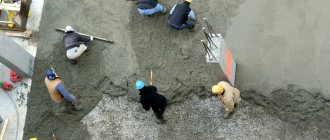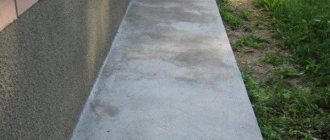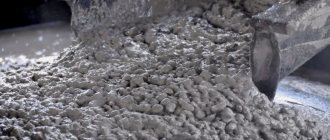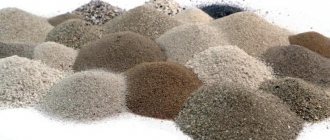Concrete preparation technology - proportions and materials
It is impossible to imagine the world around us without modern architecture. It should be remembered that concrete is, without exaggeration, the main material used in construction.
Similar material was used in Ancient Egypt. When using cement for different purposes, it is important to use the correct concrete proportions that suit the specific case. Let's talk about preparing concrete by hand.
Concrete - what is it? The physical properties of concrete will be determined by what it is made of and how it is made. In order to understand this as best as possible, it is important to pay attention to its components.
General information about concrete
Cement-based building mixtures have a long history, but have not lost their relevance today. This became possible thanks to the successful ratio of components and ease of use technology. The construction sector in our country has always stood out favorably from other industries. Its development is proceeding at a rapid pace, so a huge amount of various materials is required.
For many entrepreneurs, own concrete production is a good start for successful development. To start activities, it is enough to purchase a small plant. The equipment is affordable and you can always choose the optimal set.
We recommend:
Concrete production plant TRUMIX-30 from 1 rub.
Concrete production plant TRUMIX-60 from 1 rub.
Concrete production plant TRUMIX-90 from 1 rub.
Market research has shown that such business projects in most cases turn out to be successful, because concrete mixtures are always needed on the market and are in stable demand, which cannot be said about other types of building materials. The material is widely used in the construction of housing stock and the development of infrastructure in populated areas.
Our cities, like sponges, consume huge amounts of cement mixtures. With the onset of warm weather, this is especially noticeable - activity increases at all objects and new ones appear that require materials.
Cement production is based on a simple technological process, but is quite labor-intensive. To obtain a material of homogeneous composition, it is necessary to thoroughly mix several components according to the prescribed recipe.
At the same time, the final product cannot be stored for a long time, but is used immediately at various construction sites. If for small private construction it is possible to prepare mixtures directly on site manually, then this option is not suitable for larger objects. It is necessary to produce concrete on an industrial scale.
To provide ready-made mixtures for large construction projects, cooperation with powerful companies is used. Small businesses also have their own niche - small batches for small and medium-sized objects.
Retail trade in concrete quickly recoups costs and brings good dividends. With the increase in the number of companies involved in the construction of buildings and structures, the demand for materials for work increases. Concrete production plants play an important role in meeting this need.
Business projects in this area are highly competitive and have a quick payback.
Vibration compaction
The process of producing high-quality concrete, as a rule, involves the subsequent use of vibration installations. The most widespread type of vibration formation is bench (bench) vibration compaction. In this case, the forms with the concrete mixture are placed on a vibrating platform, which is subject to vibrations from a vibrating mechanism.
For bench vibration, vibration platforms of various types are used, this is the technological features of the method. They are classified according to the layout of the table and vibrating organ, load capacity and basic vibration parameters. According to the layout they are distinguished:
- mechanisms having one table with a vibration exciter located below;
- block-type vibration platforms, consisting of unified blocks with one vibration exciter located under the table of one of the blocks.
The loading capacity of the platforms is determined by the power of the drive motors. The most common vibrating platforms are with a lifting capacity of 3, 5, 7, 10 and 15 tons, less often – 20 and 25 tons. The load capacity of block mechanisms is in the range of 2-24 tons.
Concrete production plants
To increase efficiency and simplify maintenance, concrete production plants are equipped with automation systems. This helps reduce human involvement and reduces the number of possible errors. A small plant, with a normal operating cycle, can produce 30-60 cubic meters of mixtures per hour.
The cost of equipment sets may vary significantly. The final price of the plant depends on the type, performance and additional devices chosen by the buyer. The most affordable option can be purchased for 1.5 million rubles. For a fully automated plant with high productivity, the company needs to pay about 8-12 million rubles.
Mobile equipment for the production of concrete mixtures, in contrast to completely stationary ones, can, if necessary, be dismantled in a very short time, loaded onto platforms, transferred to a new facility and put into operation there. In this way, the entrepreneur can provide the construction site with the necessary materials right on site. Before choosing a set of equipment, you need to consider the scope of its application and the required volumes. In addition to the concrete mixing units themselves, we also offer a number of components.
Automated lines do not require a large number of workers, eliminate errors and are an excellent investment for the future. The experience of implementing such plants shows that businessmen can earn up to 1 million rubles or more monthly from them. To maintain production, it is enough to maintain a staff of three workers.
Specialists involved in the production of concrete in automated plants do not need special knowledge or lengthy training. Employers benefit from this option because they can significantly reduce costs.
Ready-made mixtures prepared by a stationary plant must be delivered to the customer on time. The load is specific and in order to avoid delamination of the concrete mixture, it requires fast delivery, so you need to purchase suitable equipment. If you choose a domestic concrete mixer truck based on a KAMAZ loading platform, you will have to spend an amount of 2.8 million rubles. Imported mixers are much more expensive.
The operating principle of all concrete plants is essentially the same. To better understand the processes occurring inside a concrete plant, which are hidden from the eye of the observer, watch this short video. Thanks to animation, the walls will become transparent and the processes clear.
Main advantages
The coating meets all the necessary requirements, which is why it has become widespread in a number of industries. Decorative concrete, thanks to the efforts of its developers, has acquired a number of undeniable advantages, among which the following should be highlighted:
- resistance to chemicals, petroleum products and aggressive compounds; resistance to ultraviolet radiation; ability to withstand high loads; resistance to abrasion and mechanical stress.
As for the ability to withstand loads, it is almost three times greater than that of pressed paving slabs. If you use pressed concrete, you can create beautiful and durable coatings. Special substances are added to the mass to prevent delamination and cracking.
Technology for the production of concrete mixtures
The modern version of the technology for using cement-based building mixtures dates back to 1824, when the British builder D. Aspdin took the first patent for the production of Portland cement. The name of the material includes the town of Portland, which is distinguished by its picturesque terrain and gray rocky mountains, so similar in color to the new building material. Since that time, cement began to spread widely throughout Europe and the world, constantly gaining popularity and conquering markets.
Domestic concrete mixtures were produced in accordance with GOST 25192. The regulatory document lists various classes, chemical and physical parameters, and grades.
Bestsellers
from 1 rub. Factory TRUMIX-30 from 1 rub. Factory TRUMIX-60 from 1 rub. Factory TRUMIX-90 from RUB 530,000. Vibropress for rings
Description
Concrete is a common artificial building material that, when hardened, takes on a stone-like shape. There are various methods for producing concrete, but most of them boil down to mixing a binder (usually cement), aggregate (sand, gravel, rubble, etc.) and water in certain proportions. To improve the quality of the mixture, various additives can be used: water repellents, plasticizers and others. When making asphalt concrete, bitumen is used instead of water.
Making panels yourself
You can make decorative concrete panels yourself. They look quite impressive, and they can be used when decorating not only the external, but also the internal walls of a building. The basis can be the same concrete, the composition of which was described above. However, you must acquire interesting shapes that will make up the surface pattern. After mixing the mixture, it is poured into molds, and after hardening, the formwork is removed.
The products must be left to rest before they can be used for installation. Installation is carried out using the same cement mortar. However, you can also use special glue. It must be reliable enough to withstand the load of products that have an impressive weight.
Other options
If it is impossible to prepare concrete for the foundation of buildings manually, you should seek the help of specialists. If you are not sure about the proportions, then the best solution would be to purchase a ready-made cube of concrete, which is designed for the construction of small structures. The cost of a cube of concrete mortar on average ranges from 2,400 to 3,200 rubles, depending on the height of the brand. Thus, the price category of M400 concrete is 3,200 rubles. The most expensive and reliable material is the M600 brand.
Return to contents
Cooking by hand
Preparation of concrete by hand.
There are two types of manual kneading:
- Cement is added to a container with water in a certain proportion. The consistency is thoroughly mixed and filler and sand are poured into it. Mix the mixture thoroughly again until smooth;
- Dry ingredients are mixed in a container. A depression is created in the center into which water is poured. Mixing occurs gradually from the edges to the center. It is necessary to constantly monitor the plasticity of the mixture by adding water.
The procedure goes as follows:
- pour the required amount of sand into a metal box or onto tin sheets 2x2 m;
- add the required volume of Portland cement depending on the brand of concrete and its purpose;
- after thoroughly mixing the components, add water and filler depending on the proportions drawn up for a specific construction;
- Repeated mixing with a shovel until the resulting mixture reaches a uniform consistency and is free of lumps.
Return to contents











